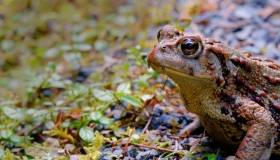
March 10, 2022 — If you’ve ever walked past a pond and crinkled your nose at the smell or had to forego eating fish due to a red tide alert, you’ve experienced the effects of an algal bloom. Although algae are an important component of a healthy ecosystem, under the right conditions they can grow and release substances that are toxic to people and animals. Algal blooms are becoming more frequent as a result of climate change and other factors, posing risks to pets and wild animals alike. Pet parents, livestock owners and wildlife lovers need to know the latest information about this increasingly important cause of disease.
Algae is a broad term for organisms that live in water
The word “algae” is commonly applied to many different types of organisms that live in water and often is applied to both plants and certain types of bacteria, protists, fungi and archea. The common feature shared by these organisms is their watery habitat and their ability to produce oxygen through photosynthesis. Algae can live in both fresh and salt water (and sometimes on land) and can vary in size from microscopic bacteria to giant kelp!
Algae are important organisms in many ways. They produce about half of the oxygen in the Earth’s atmosphere and they’re efficient consumers of carbon dioxide. There also is interest in using algae as biofuels.
Only a few types of algae produce toxins, and under normal circumstances these algae don’t pose a threat to people or animals. However, when toxin-producing algae begin to grow excessively they can release enough toxin to pose a health hazard to animals and people.
Environmental factors can trigger harmful algal blooms
Algae flourish when environmental conditions support rapid growth, resulting in what is often called harmful algal blooms (HABs). Warm water temperature, light and high water-nutrient content secondary to fertilizer run-off or sewage are ideal conditions for algal growth. Lots of algae means increased toxin production and a greater chance of adverse health effects.
Evidence suggests that increasing ocean temperatures are leading to HABs that occur more frequently, are longer in duration, and have a larger range than in the past.
HABs are caused not by just one organism
Different types of algae make different types of toxins, but these toxins often are lumped together under the term “red tide.” The table below sorts out the most common algae responsible for toxin production.
|
Organism |
Water type |
Color |
Toxin |
Target tissue |
Health effects |
|
Alexandrium sp |
Salt |
Red or brown |
Saxitoxins |
Nervous and musculoskeletal systems |
Paralytic shellfish poisoning, paralysis, death |
|
Karenia brevis |
Salt |
Red |
Brevetoxins |
Nervous and respiratory systems |
Gastrointestinal signs, muscle cramps, seizures, paralysis, respiratory difficulty |
|
Pseudonitzschia |
Salt |
Red or brown |
Domoic acid |
Nervous system |
Amnesiac shellfish poisoning, vomiting, diarrhea, confusion, seizures, memory loss, death |
|
Microcystis |
Fresh |
Blue-green |
Microcystin |
Liver |
Gastrointestinal signs, liver damage |
Adapted from the National Institute of Environmental Health Sciences
Animals and people are exposed to toxins when they drink contaminated water or eat fish from areas affected by algal blooms
Ingested toxins can work quickly in animals, with reports of clinical signs appearing within hours of exposure. In some cases, signs don’t appear for a few days post ingestion.
The clinical signs noted depend on the type of toxin ingested (see table above), but in general fall into two categories:
- Gastrointestinal signs – abdominal pain, vomiting, diarrhea
- Neurologic signs – weakness, staggering, disorientation, seizures
If exposure is known or suspected, call your veterinarian immediately even if your pet isn’t exhibiting any clinical signs.
Prevention is key
As always, preventing toxin exposure is crucial to keeping our pets, our livestock and ourselves safe from the effects of HABs. Familiarizing yourself with warnings affecting the water near a home or vacation spot is important. Keep pet and livestock away from ponds with obvious algae scum on the top. It doesn’t take a lot of toxin to cause problems!
Learn more about other waterborne diseases and other diseases affecting animals around the world. Listen to our podcasts, read up on the latest news from the Golden Retriever Lifetime Study, and find out how you can help the Foundation’s work to keep the animals we love healthy.
Additional resources:
https://oceanservice.noaa.gov/facts/redtide.html
https://www.cdc.gov/habs/be-aware-habs.html
https://www.cdc.gov/habs/ohhabs.html
https://www.niehs.nih.gov/health/topics/agents/algal-blooms/index.cfm https://www.epa.gov/national-aquatic-resource-surveys/indicators-algal-toxins-microcystin




